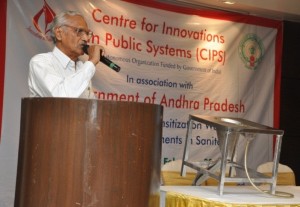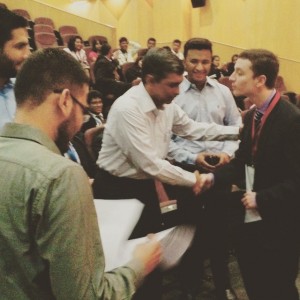Swachh Bharat Abhiyan is Government of India’s flagship program which aims to accomplish the vision of a ‘Clean India’ by 2nd October 2019, the 150th birthday of Mahatma Gandhi. Its mission is to maintain a clean environment and ‘open defecation’-free panchayat villages, blocks and districts. Despite these efforts by the Governments, rural populace isn’t still aware of the importance of better sanitation practices.
 Sri M.Dharma Rao, a retired Chief Engineer (Irrigation) of Government of AP, has pioneered a revolutionary technology “Ecological Sanitation (Ecosan) & Biodigester (DRDO) model toilets” to improve the sanitation facilities in both rural and urban areas. His model addresses the major concerns of the present and would help in achieving the goal of Swachh Bharat we all aspire for. With around four decades of experience in investigation, planning, design, construction and management of various projects, he played a vital role in executing government policies effectively. He had also received “Visishta Seva Patram” and “Seva Patram” awards for his meritorious service which helped the State to save time and costs. He is involved in several community development activities and popularization of appropriate technologies for rural development. He strongly believes in the principle “Be good and do good” for welfare of the society.
Sri M.Dharma Rao, a retired Chief Engineer (Irrigation) of Government of AP, has pioneered a revolutionary technology “Ecological Sanitation (Ecosan) & Biodigester (DRDO) model toilets” to improve the sanitation facilities in both rural and urban areas. His model addresses the major concerns of the present and would help in achieving the goal of Swachh Bharat we all aspire for. With around four decades of experience in investigation, planning, design, construction and management of various projects, he played a vital role in executing government policies effectively. He had also received “Visishta Seva Patram” and “Seva Patram” awards for his meritorious service which helped the State to save time and costs. He is involved in several community development activities and popularization of appropriate technologies for rural development. He strongly believes in the principle “Be good and do good” for welfare of the society.
Adding a feather in his cap, he had been recently conferred as the “CHAMPION OF SWACHH BHARAT SWACHH TELANGANA FOR AUGUST 2015” for his innovative design of eco-friendly and cost effective “Eco-San” toilets for the improvement of the sanitation systems, and recycling the present sanitation systems in vogue are not preventing pollution of air and water. The decomposition of waste is not happening up to the required degree. These are the findings of the pollution control agencies, water supply and ground water departments of the Government.
The model we proposed is based on nature’s principle of sustenance of ecology by recycling. Further, earthworms are used for conversion of fecal material to compost. Urine is also diverted and stored in a separate container for using it as a liquid fertilizer. Hence, the waste in its totality is covered and decomposed at a faster rate than in nature. This model also ensures that the whole process is eco -friendly and does not pollute our natural resources, human waste into valuable organic manure.
Foundation for Democratic Reforms, which advocates an integrated approach to the sanitation challenges, congratulates him on this occasion and speaks to the veteran about the sanitation issues and amicable solutions, his insights and cryptic message to the youth of India.
1.What inspired you to come up with this innovation?
In our country about 50% of people do not have the facility of a latrine and they are forced to defecate in the open fields. This is causing pollution of air and water. This leads to the spread of disease causing pathogens due to which people get sick. Diseases push the poor people into extreme poverty.
Therefore we have tried to develop a model toilet which is sustainable, cost effective and one which recycles human waste into fertilizer (compost) which could be used to enrich the soil.
2. How do you think that your model addresses the present sanitation problem in the country?
The present sanitation systems in vogue are not preventing pollution of air and water. The decomposition of waste is not happening up to the required degree. These are the findings of the pollution control agencies, water supply and ground water departments of the Government.
The model we proposed is based on nature’s principle of sustenance of ecology by recycling. Further, earthworms are used for conversion of fecal material to compost. Urine is also diverted and stored in a separate container for using it as a liquid fertilizer. Hence, the waste in its totality is covered and decomposed at a faster rate than in nature. This model also ensures that the whole process is eco -friendly and does not pollute our natural resources.
3. What is the scope for this design and how do you want to spread awareness about it in the rural populace of the country?
We have constructed these models and they have been tested by the officers of the concerned departments and their efficacy is widely recognized. Governments of Telangana & AP have been asked to follow this ecological principle and accept this practical design for construction of new toilets. Government of Telangana has acknowledged the model on their website of Commissioner & Director of Municipal Administration.
4.Are there any practical difficulties in adopting implementing this model on a large scale?
There are no practical problems as this model can be constructed with locally available material. Moreover we have developed a model RCC pre-fabricated which can be located centrally for a district or a region. The toilet structure can be erected even in narrow place and on any type of land.
5. With such a huge population and growing consumption, we also face another major challenge – “Solid Waste Management”. How do you think we manage our waste better?
Regarding solid waste management we are developing an off grid waste management system wherein we can recycle locally where the waste is generated instead of transporting entire waste over long distance for conversion and treatment. Our model is small and comes in localized units. Thereby bulk transportation of untreated waste is not required and people will not be exposed to polluted air, smoke and dust.
6. Do you have any suggestions for the upcoming generations?
Science has developed so much that we have got simple technological solutions available for each and every problem. The only thing required from our end is motive of serving common man which is our sacred duty.
There are sufficient resources and talent available to fulfil the genuine needs of the society but insufficient to satisfy our greed, the father of the nation observed wisely and prophetically.
***


